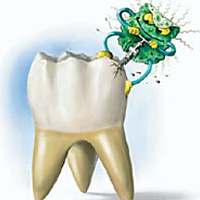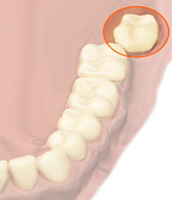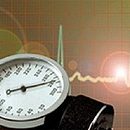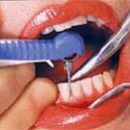The prevention of infectious endocarditis in dental patients suffering from the pathology of the heart is mandatory. Most often, the impetus for the development of septic endocarditis is bacteremia that occurs during the extraction of the tooth or carious defeat. The risk of developing bacteremia significantly increases in the presence of an infection in the oral cavity.
Content
Causes of infectious endocarditis in dentistry
 Infective endocarditis is a bacterial damage of heart valves, endocardium or endothelium adjacent to cardiac or vascular formations. In the mechanism of development of this pathology play the role of heart defects, creating a platform for the development of this threatening life of the disease. Most often, transient bacteremia is the impetus for the development of septic endocarditis. Transient Bacteremia S. Viridans is usually observed if after dental procedures, the extraction of the tooth, the tonsillectomy of the vehicle is irrigated by a stream of water, or in cases where patients immediately after these procedures start eating food. The risk of bacteremia increases significantly in the presence of any infectious lesions of the oral cavity.
Infective endocarditis is a bacterial damage of heart valves, endocardium or endothelium adjacent to cardiac or vascular formations. In the mechanism of development of this pathology play the role of heart defects, creating a platform for the development of this threatening life of the disease. Most often, transient bacteremia is the impetus for the development of septic endocarditis. Transient Bacteremia S. Viridans is usually observed if after dental procedures, the extraction of the tooth, the tonsillectomy of the vehicle is irrigated by a stream of water, or in cases where patients immediately after these procedures start eating food. The risk of bacteremia increases significantly in the presence of any infectious lesions of the oral cavity.
The second most important, but incomparably more frequent pathology is the carious dental defeat caused by the green streptococci of the Mutans biohroup. Microorganisms contain surface protein, binding glycoproteins of saliva on the surface of the teeth, and (together with other bacteria) form bacterial plaques on the teeth. They convert sucrose with food into the milk acid, causing demoormalization of the enamel of teeth. It should be noted that many microorganisms living in the oral cavity are capable of forming milk acid from sucrose, but only streptococci groups of Mutans and lactobacillos are capable of forming lactic acid at low pH values, t.E. Induced the development of lesions.
Risk Groups for the Development of Infectious Endocarditis
High risk of developing the disease:
- Prosthetized Heart Valves, including Bioprostheses and Homo (Hello) Gene transplants
- Bacterial endocarditis in history
- Surgically created systemic pulmonary shunts
- Complex congenital heart diseases accompanied by cyanosis
The average risk of developing the disease:
- Most of the other congenital heart pathology (for example, the presence of arterial duct, the defects of the ventricular partition, the defects of the atrial partition, coarctation of the aorta, the tricuspid aorta valve)
- Acquired valve dysfunction (for example, rheumatic heart lesions)
- Hypertrophic cardiomyopathy
- Prolapse of the Mitral Valve, accompanied by regurgitation and / or thinning of sash
- Category of minor risk factors, in which endocarditis prevention is not recommended, presented below
Minor risk of infectious endocarditis:
- PROLAPS Mitral Valve without regurgitation
- Isolated secondary defect of the atrial partition
- Surgical treatment of the defect of the atrial partition, ventricular partition or arterial duct (without recurrence in the next 6 months)
- Aorticonal artery shunting in history
- Physiological, functional heart noises
- Cavasaki disease without valve dysfunction in history
- Rheumatic fever without valve dysfunction in history
- Availability of rhythm drivers (intravascular or epicardial) and implanted defibrillators
Manipulation of a dentist in the oral cavity
 Bacteremia is the presence of viable bacteria in systemic bloodstream. Bacteremia can be transient intermittent or constant. Food or teeth cleaning can cause transient bacteremia. Periodontal diseases may cause intermittent bacteremia. Abscess in the oral cavity can cause constant bacteremia. Circulating microorganisms may be deposited in the zone of cardiac defects and lead to the development of hard or even fatal bacterial endocarditis.
Bacteremia is the presence of viable bacteria in systemic bloodstream. Bacteremia can be transient intermittent or constant. Food or teeth cleaning can cause transient bacteremia. Periodontal diseases may cause intermittent bacteremia. Abscess in the oral cavity can cause constant bacteremia. Circulating microorganisms may be deposited in the zone of cardiac defects and lead to the development of hard or even fatal bacterial endocarditis.
Some dental procedures can cause bacteremia potentially pathogenic microorganisms. The relationship between some dental procedures, pathogenetic bacteriamia and bacterial endocarditis remains theoretical. However, it is believed that certain dental manipulations that significantly affect blood flow, increase the risk of developing IE. Aka clearly divided dental procedures in which prevention is shown, from those in which it is not recommended to carry out prevention.
Dental procedures in which endocarditis prevention is recommended:
- Extraction tooth
- Periodontological procedures, including surgical operations, Curetzh, root treatment, probing
- Installation of dental implant
- Demplantation of teeth
- Endodontic treatment leaving anopex
- Sub-hypigital installation of antibacterial threads or strips
- Installation of orthodontic tapes
- Intralyigative introduction of local anesthetic
- Preventive manipulations that cause bleeding
Dental procedures under which endocarditis prevention is not recommended:
- Orthopedic dentistry, prosthetics
- Local injections
- Intracinal endodontic treatment
- Installation of cafedama
- Removal of seams
- Removal or adjustment of orthodontic devices
- Removing blinds
- Fluorination
- Radiography
- Loss of milk teeth
Oral care with infectious endocarditis
Care of the oral cavity includes personal hygiene and regular professional care in order to remove plates and monitor dental diseases. Before being subjected to a surgical operation about heart disease or vessels, the patient will be useful to undergo a full inspection of the dentist, followed by the treatment of diagnosed diseases, which will reduce the risk of bacteremia. Elimination of centers of acute or chronic infection with the help of the necessary extraction, endodontic or periodontal treatment can reduce the risk of bacteremia. It is sometimes useful to rinse the oral cavity with a solution of a local oral antiseptic, for example, chlorhexidine.









